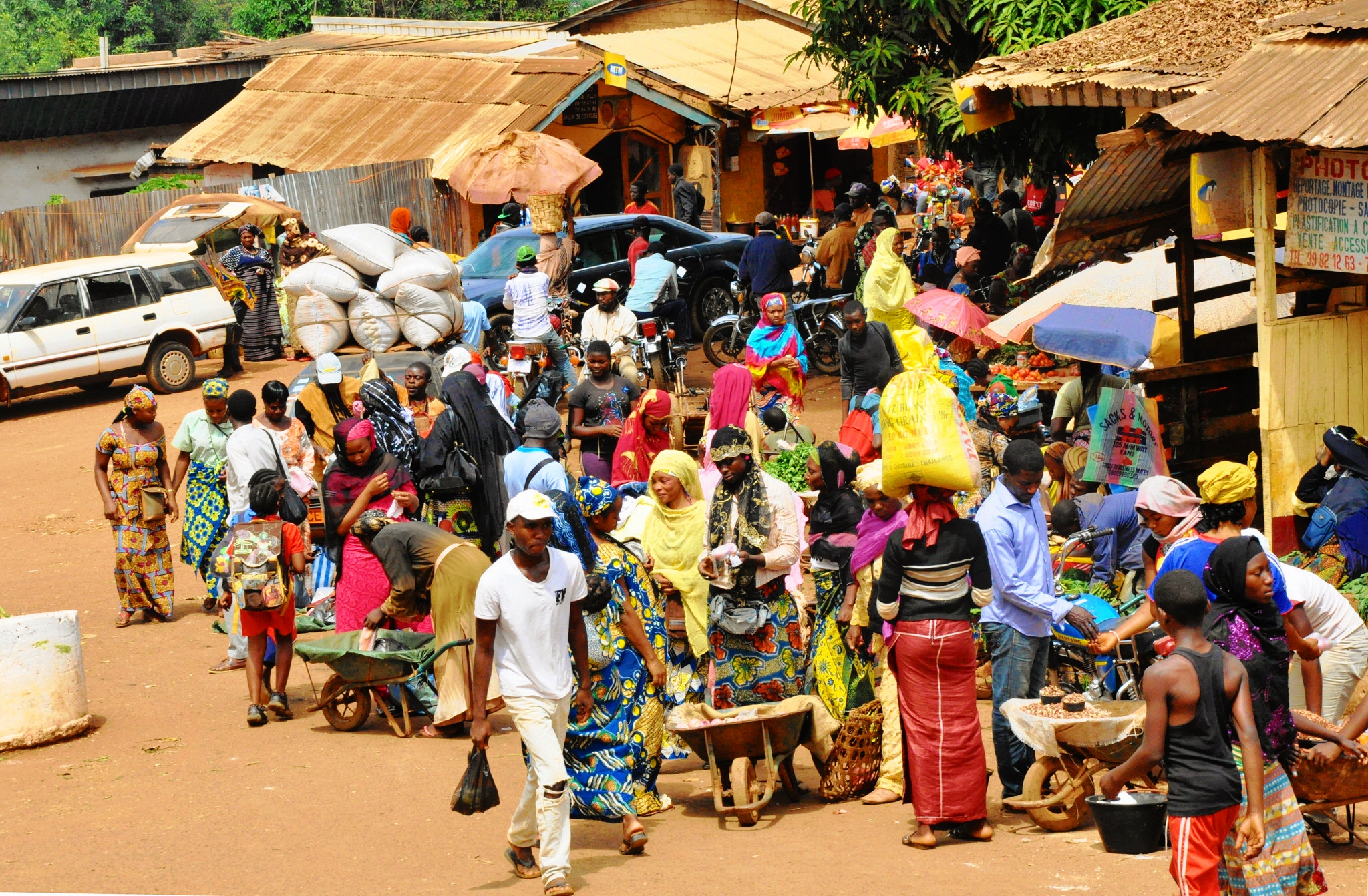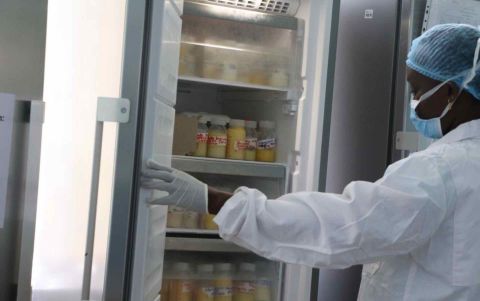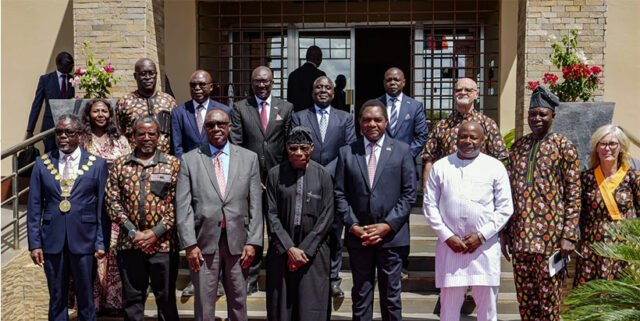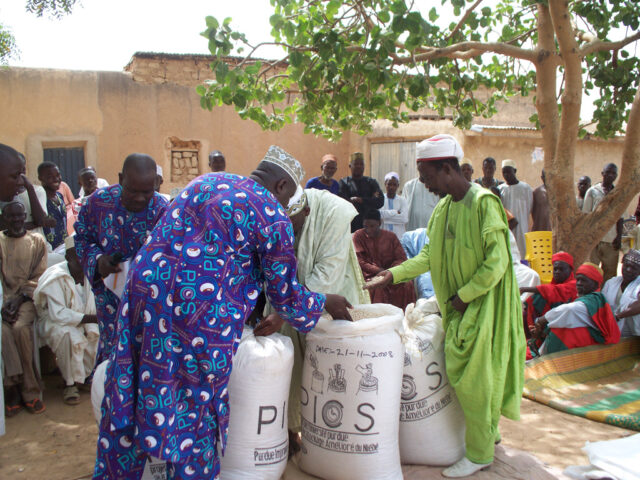
By Dolapo Enahoro, Charles Mensah, and Sika Gbegbelegbe
Food, land, and water systems face daunting challenges in the future, and the body of research exploring these challenges is growing rapidly. This note is part of a series developed by the CGIAR Foresight Initiative to summarize what we know today about the future of various aspects of food systems. The goal of these notes is to serve as a quick reference, point to further information, and help guide future research and decisions.
Key messages
- Food systems in West and Central Africa are challenged by population growth, slow growth in productivity and incomes, and climate change.
- Urbanization and related trends are creating new opportunities for the region’s agricultural value chains to meet nutrition and employment needs, including those of women and young people.
- However, climate change poses a significant threat to future agricultural production in the region, and dependency on food imports is mostly projected to increase.
- Foresight studies that account for the future can help guide the transformation of food, land, and water systems in WCA in response to climate change. However, new analyses are needed to address the multi-dimensional nature of the challenges faced by the region.
Background, recent trends, and challenges
Countries in Western and Central Africa (WCA) are facing immense pressure to meet the growing food, nutrition, employment, and other needs of their increasing urban populations (OECD/UNECA/AfDB, 2022). The region’s vulnerability to climate change and low adaptive capacities due to socio-economic and physical characteristics makes it hard to respond effectively to these challenges (Fuller et al., 2018; Partey et al., 2018).
In the last ten years, WCA’s total population increased by 29%, compared to a 10% increase in the world’s population, while WCA’s urban population increased by 45% compared to a 19% increase globally (FAO, 2022a). The strong growth in urbanization has been driving (along with population growth) higher demand in the region for cereals, animal-source foods and other food types associated with more urbanized diets (EUC, 2019; Kruseman et al., 2020; Latino et al., 2020).
The demographic changes have however occurred alongside poor economic performances across the region, characterized by slow economic growth, low incomes, and high rates of unemployment and underemployment, particularly in rural areas (AfDB, 2019, 2020; Musibau et al., 2022). An estimated 90 million of the region’s 600-plus million people live in poverty (CGIAR, 2022). Although progress has been made in the past two decades, hunger and malnutrition are still high in the region, and have been exacerbated in the last two years by the COVID-19 pandemic and by the war in Ukraine (Chadare et al., 2022; FAO, 2022b; Udmale et al., 2020).
Low agricultural productivity, weak local markets for agricultural and food products, and negative effects of global climate change on the natural resource base constitute major threats to the future of food security and livelihoods in WCA (CGIAR, 2022). A combination of high temperatures that are above global averages, extreme climate events, civil conflicts, food insecurity, and economic hardship may have already contributed to the displacement of an estimated 17 million people in the region over the last two decades (Padgham et al., 2015; Filho et al., 2022; WFP, 2017).
What is the latest foresight research on food systems in WCA?
Given the myriad of interacting demographic, socio-cultural and political, infrastructural, technological, and environmental challenges that West and Central Africa faces (SWAC/OECD, 2021), it will be important for decision-makers to better understand the transformation trends of the region’s food, land, and water systems, and how these trends and their impacts are likely to evolve in the coming decades.
Climate change may be the most important long-term driver of food system change against which other trends (such as migration and urbanization) and interventions (including policies and investments) will need to be addressed (OECD/UNECA/AfDB, 2022; CGIAR, 2022). This brief highlights some of the key studies relevant to the discourse. These studies analyzed the potential effects of climate change on agricultural land and production in West and Central Africa (Akpoti et al., 2022; Ugbaje et al., 2019; Manners et al., 2021; Zabel et al., 2014); the impacts of income and population growth on food security (Jalloh et al., 2013); and linkages of future land use to food security in the region under alternative scenarios, including climate change (de Lattre-Gasquet et al., 2018).
In Akpoti et al., (2022), a spatially explicit modeling approach and an ensemble of spatially downscaled and bias-corrected climate data were used to project changes in areas suitable for rice production in West Africa, compared to the baseline, for four time periods between 2030 and 2080. The projected changes, which result from variations in temperature and precipitation brought about by climate change, are in the order of 22% to 33% rice area losses under the lowest reduction scenarios and more than 50% loss in the extreme case. The study suggested that strong adaptation measures along with technological advancement and adoption will be needed to address the adverse effects of climate change on agricultural production in the region. Ugbaje et al., (2019) similarly showed in the case of maize that, relative to the current situation where more than 90% of West Africa is at least moderately suitable for production, agricultural suitability will change in at least 43% of West Africa under future climate change, mostly owing to changes in temperature. Under the worst-case scenario simulated in that study, only about 15% of the West African region remains suitable for maize production by 2080. A similar study analyzing crop suitability in Central Africa indicated that climate change will be somewhat favorable to root, tuber, and banana-based systems under specified agronomic practices, with widespread negative impacts seen only for potato (Manners et al., 2021). This result supports projections from an earlier global study showing that the importance of root, tuber, and banana crops for food security will likely increase in the world’s poorest regions (Petsakos et al., 2019). For West Africa, it is likely that land suitability for agriculture would worsen in the northern part and should improve somewhat in the southern part by 2071-2100 (Zabel et al. 2014). A similar trend is also likely for central Africa (Zabel et al., 2014).
The studies highlighted above generally agree that climate change will affect agricultural productivity and total food production, which have implications for poverty, food security, and nutrition. An earlier study had shown that malnutrition could increase across the region under persisting conditions of low incomes and high population growth (Jalloh et al., 2013). Further, Rigaud et al., (2021) estimated that ultimately due to climate change, West Africa alone could see the internal displacement of as many as 32 million people by 2050. A different study linking changes in agricultural land and production to food importation and food self-sufficiency further buttresses food security dimensions of the impacts of climate change in WCA. de Lattre-Gasquet et al., (2018), using an analytical framework that combines quantitative and qualitative approaches, showed that even where arable and permanent crop areas as well as pastures and meadows increase in West and Central Africa, overall food production is likely to be insufficient, and food import dependency is likely to increase. In that study, a regionalization scenario was the exception, in which import demand in West Africa, particularly of animal products, was projected to decline. These results derived from the study’s accounting for amongst others, future scenarios of urbanization and rural transformation, dietary changes, and climate change and sustainability.
The studies raise questions about what governments, civil society, and other decision makers in the region may need to do to position their countries to meet future challenges of food security. They also highlight the relevance to national planning (including on land use), of adequately accounting for multiple scenarios of future change.
Key gaps and opportunities for further foresight research
Foresight studies for WCA generally agree that climate change will have significant impacts on agricultural and food systems in the region, from crop suitability and agricultural productivity to food production, food import dependency, and migration. These impacts can be small or large, negative, or positive for the different crops, food systems, and/or geographies. Indications are that emerging demographic and socioeconomic trends will interact with biophysical changes to generate increased challenges to the food security of WCA in the future. However, these interactions have often not been explicitly or fully analyzed. It is not obvious what the impacts (e.g., on nutrition, food security, and employment) will be under climate change, of ongoing trends related to urbanization or dietary change, or how the important trade-offs that emerge between these impacts should be managed. While there are indications of increased food dependency in the region, there are very few quantitative region-wide simulations to show whether these will have negative or positive impacts for WCA in the overall, i.e., beyond meeting foremost or initial objectives of food security. In addition, most foresight studies targeting WCA have not considered weather extremes, or the biotic impacts linked to climate change.
Thus, additional quantitative analyses are needed to link alternative scenarios of future climate change, characterized by changes, as well as extremes, in temperature, precipitation, and other abiotic indices, not just to agricultural production, but to biotic impacts and to agricultural value chains and food systems in their entirety. That way, the interactions of climate change with demographic (including urbanization and migration), socioeconomic (including gender and youth), technological, and environmental factors and impacts in WCA, can be more adequately captured. Finally, there may be incentives to explore synergies between quantitative and qualitative foresight approaches to support the governance and implementation of sustainable food systems transformation in WCA.
The authors of this note are Dolapo Enahoro, Senior Agricultural Economist, International Livestock Research Institute (ILRI); Charles Mensah, Research Officer, ILRI; and Sika Gbegbelegbe, Agricultural Economist (Foresight Modeler), International Institute of Tropical Agriculture (IITA).
If you have any feedback or questions about this note, please get in touch with Dolapo Enahoro (d.enahoro@cgiar.org).
For more information, check out these resources:
AfDB. (2019). Central Africa Regional Integration Strategy Paper, 2019-2025. https://www.Afdb.Org/En/Documents/Central-Africa-Regional-Integration-Strategy-Paper-2019-2025. Accessed 26 December 2022.
AfDB. (2020). West Africa Regional Integration Strategy Paper, 2020-2025. https://www.Afdb.Org/En/Documents/West-Africa-Regional-Integration-Strategy-Paper-2020-2025-0. Accessed 26 December 2022.
Akpoti, K., Groen, T., Dossou-Yovo, E., Kabo-bah, A. T., & Zwart, S. J. (2022). Climate change-induced reduction in agricultural land suitability of West-Africa’s inland valley landscapes. Agricultural Systems, 200. https://doi.org/10.1016/j.agsy.2022.103429
CGIAR. (2022). CGIAR Research Initiative: West and Central African Food Systems Transformation. https://www.cgiar.org/initiative/22-market-driven-resilient-and-nutritious-agrifood-systems-in-the-humid-zones-of-west-and-central-africa/. Accessed 26 December 2022.
Chadare, F. J., Affonfere, M., Aidé, E. S., Fassinou, F. K., Salako, K. v., Pereko, K., Deme, B., Failler, P., Kakaï, R. L. G., & Assogbadjo, A. E. (2022). Current state of nutrition in West Africa and projections to 2030. Global Food Security, 32. https://doi.org/10.1016/j.gfs.2021.100602
Chan, C. Y., Tran, N., Pethiyagoda, S., Crissman, C. C., Sulser, T. B., & Phillips, M. J. (2019). Prospects and challenges of fish for food security in Africa. Global Food Security, 20, 17–25. https://doi.org/10.1016/j.gfs.2018.12.002
de Lattre-Gasquet, M., Moreau, C., & Okul, J. (2018). Regional Dimension of the Agrimonde-Terra Scenarios: The Example of sub-Saharan Africa. In C. le Mouël & M. O. de Lattre-Gasquet (Eds.), Land Use and Food Security in 2050: a Narrow Road. . https://esa.un.org/unpd/wpp/
Enahoro, D., Lannerstad, M., Pfeifer, C., & Dominguez-Salas, P. (2018). Contributions of livestock-derived foods to nutrient supply under changing demand in low- and middle-income countries. Global Food Security, 19, 1–10. https://doi.org/10.1016/j.gfs.2018.08.002
EUC. (2019). Global Food Supply and Demand: Consumer trends and trade challenges. EU Agricultural Market Briefs. No. 16 September 2019. European Union: Commission. EUC:
FAO. (2022a). Food and Agriculture Organization of the United Nations. FAOSTAT Statistical Database. Rome: FAO https://www.fao.org/faostat/en/#data.
FAO. (2022b). Impact of the Ukraine-Russia conflict on global food security and related matters under the mandate of the Food and Agriculture Organization of the United Nations. https://www.fao.org/3/nj164en/nj164en.pdf
Filho, W. L., Olaniyan, O. F., & Alverio, G. N. (2022). Where to go? Migration and climate change response in West Africa. Geoforum, 137(May), 83–87. https://doi.org/10.1016/j.geoforum.2022.10.011
Fuller, T. L., Sesink Clee, P. R., Njabo, K. Y., Tróchez, A., Morgan, K., Meñe, D. B., Anthony, N. M., Gonder, M. K., Allen, W. R., Hanna, R., & Smith, T. B. (2018). Climate warming causes declines in crop yields and lowers school attendance rates in Central Africa. Science of The Total Environment, 610–611, 503–510. https://doi.org/https://doi.org/10.1016/j.scitotenv.2017.08.041
Hertel, B. T. W., Baldos, U. L. C., & Fuglie, K. O. (2020). Trade in technology: A potential solution to the food security challenges of the 21st century. European Economic Review, 127. https://doi.org/10.1016/j.euroecorev.2020.103479
Jalloh, Abdulai; Nelson, Gerald C.; Thomas, Timothy S.; Zougmoré, Robert and Roy-Macauley, Harold. 2013. West African agriculture and climate change: A comprehensive analysis. IFPRI Research Monograph. Washington, D.C. International Food Policy Research Institute http://dx.doi.org/10.2499/9780896292048
Kruseman, G., Mottaleb, K. A., Tesfaye, K., Bairagi, S., Robertson, R., Mandiaye, D., Frija, A., Gbegbelegbe, S., Alene, A., & Prager, S. (2020). Rural transformation and the future of cereal-based agri-food systems. Global Food Security, 26. https://doi.org/10.1016/j.gfs.2020.100441
Latino, L. R., Pica-Ciamarra, U., & Wisser, D. (2020). Africa: The livestock revolution urbanizes. Global Food Security, 26. https://doi.org/10.1016/j.gfs.2020.100399
Manners, R., Vandamme, E., Adewopo, J., Thornton, P., Friedmann, M., Carpentier, S., Ezui, K. S., & Thiele, G. (2021). Suitability of root, tuber, and banana crops in Central Africa can be favoured under future climates. Agricultural Systems, 193. https://doi.org/10.1016/j.agsy.2021.103246
Muiderman, K. (2022). Approaches to anticipatory governance in West Africa: How conceptions of the future have implications for climate action in the present. Futures, 141. https://doi.org/10.1016/j.futures.2022.102982
Musibau, H. O., Shittu, W. O., & Yanotti, M. (2022). Natural resources endowment: What more does West Africa need in order to grow? Resources Policy, 77. https://doi.org/10.1016/j.resourpol.2022.102669
OECD/UNECA/AfDB. (2022). Africa’s Urbanisation Dynamics 2022: The Economic Power of Africa’s Cities, West African Studies, OECD Publishing, Paris, https://doi.org/10.1787/3834ed5b-en.
Padgham, J., Jabbour, J., & Dietrich, K. (2015). Managing change and building resilience: A multi-stressor analysis of urban and peri-urban agriculture in Africa and Asia. Urban Climate, 12, 183–204. https://doi.org/10.1016/j.uclim.2015.04.003
Partey, S. T., Zougmoré, R. B., Ouédraogo, M., & Campbell, B. M. (2018). Developing climate-smart agriculture to face climate variability in West Africa: Challenges and lessons learnt. Journal of Cleaner Production, 187, 285–295. https://doi.org/10.1016/j.jclepro.2018.03.199
Petsakos, A., Prager, S. D., Gonzalez, C. E., Gama, A. C., Sulser, T. B., Gbegbelegbe, S., Kikulwe, E. M., & Hareau, G. (2019). Understanding the consequences of changes in the production frontiers for roots, tubers and bananas. Global Food Security, 20, 180–188. https://doi.org/10.1016/j.gfs.2018.12.005
Rigaud, K. K., de Sherbinin, A., Jones, B., Adamo, S., Maleki, D., Abu-Ata, N. E., Casals Fernandez, A. T., Arora, A., Chai-Onn, T., & Mills, B. 2021. Groundswell Africa: Internal Climate Migration in West African Countries. Washington, DC: The World Bank.
SWAC/OECD. (2021). Food system transformations in the Sahel and West Africa: Implications for people and policies. Maps & Facts, 4, 1–37. https://www.oecd.org/swac/maps/Food-systems-Sahel-West-Africa-2021_EN.pdf
Udmale, P., Pal, I., Szabo, S., Pramanik, M., & Large, A. (2020). Global food security in the context of COVID-19: A scenario-based exploratory analysis. Progress in Disaster Science, 7, 100120. https://doi.org/https://doi.org/10.1016/j.pdisas.2020.100120
Ugbaje, S. U., Odeh, I. O. A., & Bishop, T. F. A. (2019). Fuzzy measure-based multicriteria land assessment for rainfed maize in West Africa for the current and a range of plausible future climates. Computers and Electronics in Agriculture, 158, 51–67. https://doi.org/10.1016/j.compag.2019.01.011
Vervoort, J., & Gupta, A. (2018). Anticipating climate futures in a 1.5 °C era: the link between foresight and governance. Current Opinion in Environmental Sustainability, 31, 104–111. https://doi.org/10.1016/j.cosust.2018.01.004
WFP. (2017). At the Root of Exodus: Food Security, Conflict and International Migration. Rome: World Food Programme.
Zabel, Florian, Birgitta Putzenlechner, and Wolfram Mauser. “Global agricultural land resources–a high resolution suitability evaluation and its perspectives until 2100 under climate change conditions.” PloS one 9, no. 9 (2014): e107522.



